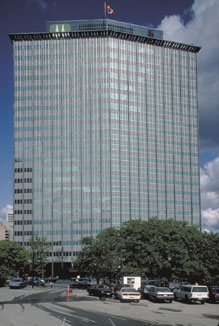Browse "Business & Economics"
-
Article
BC Hydro
BC Hydro and Power Authority (BC Hydro), a provincial Crown corportation is the third-largest electric utility in Canada.
"https://d2ttikhf7xbzbs.cloudfront.net/media/media/81dcdef6-e2cf-4f68-9df0-3cff9cd951b2.jpg" // resources/views/front/categories/view.blade.php
https://d2ttikhf7xbzbs.cloudfront.net/media/media/81dcdef6-e2cf-4f68-9df0-3cff9cd951b2.jpg
-
Macleans
BC Telecom/Telus Merger
This article was originally published in Maclean’s magazine on 8 March 1999. Partner content is not updated. George Petty is a plain-speaking guy, not prone to superlatives. So when he told Telus Corp. shareholders last April that he wanted to turn the Alberta telecommunications company into one of the worlds "premier communications" firms, he was not bluffing.
"https://development.thecanadianencyclopedia.ca/images/tce_placeholder.jpg?v=e9dca980c9bdb3aa11e832e7ea94f5d9" // resources/views/front/categories/view.blade.php
https://development.thecanadianencyclopedia.ca/images/tce_placeholder.jpg?v=e9dca980c9bdb3aa11e832e7ea94f5d9
-
Macleans
BCE Bids for CTV
Watch what I do, not what I say. That, in effect, is how BCE Inc. chief executive Jean Monty explained the latest and boldest step in his campaign to reinvent the Montreal-based telecommunications giant as the dominant provider of Canadian content on the Internet.This article was originally published in Maclean's Magazine on March 6, 2000
"https://development.thecanadianencyclopedia.ca/images/tce_placeholder.jpg?v=e9dca980c9bdb3aa11e832e7ea94f5d9" // resources/views/front/categories/view.blade.php
https://development.thecanadianencyclopedia.ca/images/tce_placeholder.jpg?v=e9dca980c9bdb3aa11e832e7ea94f5d9
-
Macleans
BCE Sells Nortel
If it's true that you've got to be smart to be lucky, then Jean Monty is one heck of a smart businessman. A year ago, the chief executive officer of BCE Inc. flirted with the idea of swapping the conglomerate's 39-per-cent stake in Nortel Networks Corp.This article was originally published in Maclean's Magazine on February 7, 2000
"https://development.thecanadianencyclopedia.ca/images/tce_placeholder.jpg?v=e9dca980c9bdb3aa11e832e7ea94f5d9" // resources/views/front/categories/view.blade.php
https://development.thecanadianencyclopedia.ca/images/tce_placeholder.jpg?v=e9dca980c9bdb3aa11e832e7ea94f5d9
-
Macleans
BCE, Thomson Create Media Colossus
Over the past year, Jean Monty has been buying up properties and piling them on top of one another much like a winner at a blackjack table stacks his chips in multicoloured towers. In February, the chairman and chief executive of BCE Inc. dished out $6.8 billion for control of Teleglobe Inc.This article was originally published in Maclean's Magazine on September 25, 2000
"https://development.thecanadianencyclopedia.ca/images/tce_placeholder.jpg?v=e9dca980c9bdb3aa11e832e7ea94f5d9" // resources/views/front/categories/view.blade.php
https://development.thecanadianencyclopedia.ca/images/tce_placeholder.jpg?v=e9dca980c9bdb3aa11e832e7ea94f5d9
-
Article
Beaver Club
Beaver Club, Montréal club, founded in 1785. Admission was restricted to fur trade veterans of the pays d'en haut.
"https://development.thecanadianencyclopedia.ca/images/tce_placeholder.jpg?v=e9dca980c9bdb3aa11e832e7ea94f5d9" // resources/views/front/categories/view.blade.php
https://development.thecanadianencyclopedia.ca/images/tce_placeholder.jpg?v=e9dca980c9bdb3aa11e832e7ea94f5d9
-
"https://d2ttikhf7xbzbs.cloudfront.net/media/media/aba6df04-519f-411d-a59b-39f712ac1359.jpg" // resources/views/front/categories/view.blade.php
https://d2ttikhf7xbzbs.cloudfront.net/media/media/aba6df04-519f-411d-a59b-39f712ac1359.jpg
-
Article
Beaver Records Ltd.
Beaver Records Ltd. Company established in 1950 by the Toronto lawyer, musical patron, and supporter of the Toronto Mendelssohn Choir F.R. MacKelcan (1882-1962), with the purpose of recording the choir.
"https://development.thecanadianencyclopedia.ca/images/tce_placeholder.jpg?v=e9dca980c9bdb3aa11e832e7ea94f5d9" // resources/views/front/categories/view.blade.php
https://development.thecanadianencyclopedia.ca/images/tce_placeholder.jpg?v=e9dca980c9bdb3aa11e832e7ea94f5d9
-
Macleans
Belgian Brewery Buys Labatt
This article was originally published in Maclean’s magazine on June 19, 1995. Partner content is not updated. Then, three months ago, an opening suddenly appeared when takeover artist Gerald Schwartz of Toronto-based Onex Corp. began laying the groundwork for a hostile bid of $2.3 billion for John Labatt Ltd. of Toronto.
"https://d2ttikhf7xbzbs.cloudfront.net/media/media/6782095b-65cd-44ab-9e7f-b4d948ff708e.jpg" // resources/views/front/categories/view.blade.php
https://d2ttikhf7xbzbs.cloudfront.net/media/media/6782095b-65cd-44ab-9e7f-b4d948ff708e.jpg
-
Article
Bell Canada Enterprises Inc
Incorporated by an act of Parliament on 29 April 1880, the Bell Telephone Company of Canada (today Bell Canada) received by its charter the right to construct telephone lines alongside all public rights-of-way in Canada, a most valuable privilege.
"https://d2ttikhf7xbzbs.cloudfront.net/media/media/9e3823dd-0d42-41c9-b648-6e704a1cbbd2.jpg" // resources/views/front/categories/view.blade.php
https://d2ttikhf7xbzbs.cloudfront.net/media/media/9e3823dd-0d42-41c9-b648-6e704a1cbbd2.jpg
-
Macleans
Bell Canada Faces Dismantling
In the future, when investors and consumers ask themselves when everything changed in the telecommunications industry in Canada, they'll invariably look back on this last week of June.This article was originally published in Maclean's Magazine on July 9, 2007
"https://development.thecanadianencyclopedia.ca/images/tce_placeholder.jpg?v=e9dca980c9bdb3aa11e832e7ea94f5d9" // resources/views/front/categories/view.blade.php
https://development.thecanadianencyclopedia.ca/images/tce_placeholder.jpg?v=e9dca980c9bdb3aa11e832e7ea94f5d9
-
Article
Bell Piano and Organ Co.
Bell Piano and Organ Co. Instrument-manufacturing firm. Established in 1864 in Guelph, Canada West (Ontario) by the brothers William and Robert Bell with a staff of three, it produced 25 four-legged 'Diploma' melodeons in its first year.
"https://development.thecanadianencyclopedia.ca/images/tce_placeholder.jpg?v=e9dca980c9bdb3aa11e832e7ea94f5d9" // resources/views/front/categories/view.blade.php
https://development.thecanadianencyclopedia.ca/images/tce_placeholder.jpg?v=e9dca980c9bdb3aa11e832e7ea94f5d9
-
Macleans
Bennett Donates M & S to U of T
When the larger-than-life Jack McClelland ran the venerable Canadian publishing house co-founded by his father, McClelland & Stewart was no stranger to headlines.This article was originally published in Maclean's Magazine on July 10, 2000
"https://development.thecanadianencyclopedia.ca/images/tce_placeholder.jpg?v=e9dca980c9bdb3aa11e832e7ea94f5d9" // resources/views/front/categories/view.blade.php
https://development.thecanadianencyclopedia.ca/images/tce_placeholder.jpg?v=e9dca980c9bdb3aa11e832e7ea94f5d9
-
Article
Berliner Gramophone Company
Berliner Gramophone Company. First record company in Canada and the manufacturer of 'Gram-O-Phone' records and talking machines.
"https://development.thecanadianencyclopedia.ca/images/tce_placeholder.jpg?v=e9dca980c9bdb3aa11e832e7ea94f5d9" // resources/views/front/categories/view.blade.php
https://development.thecanadianencyclopedia.ca/images/tce_placeholder.jpg?v=e9dca980c9bdb3aa11e832e7ea94f5d9
-
Macleans
Black Indicted over Non-Compete Clause
In the fall of 2000, as part of the back-and-forth dealing to sell some community newspapers, a Hollinger International executive named Mark Kipnis told the buyers he wanted a change in the purchase agreement.This article was originally published in Maclean's Magazine on December 12, 2005
"https://development.thecanadianencyclopedia.ca/images/tce_placeholder.jpg?v=e9dca980c9bdb3aa11e832e7ea94f5d9" // resources/views/front/categories/view.blade.php
https://development.thecanadianencyclopedia.ca/images/tce_placeholder.jpg?v=e9dca980c9bdb3aa11e832e7ea94f5d9
